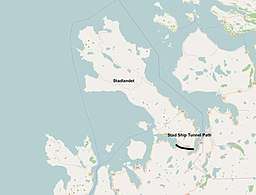Stad Ship Tunnel
The Stad Ship Tunnel (Norwegian: Stad skipstunnel) is a planned canal and tunnel to bypass the Stad peninsula in Stad Municipality in Vestland county, Norway.[1] The peninsula is one of the most exposed areas on the coast, without any outlying islands to protect it from the weather. The section has traditionally been one of the most dangerous along the coast of Norway.[2][3]


Two paths have been proposed: one 1,800 meters (5,900 ft) long from the Eide farm at the inner part of the Moldefjorden through the Mannseidet isthmus to the Kjødspollen (the inner part of the Vanylvsfjorden), the narrowest but innermost place of the peninsula.[4] The other option is a slightly longer tunnel from the Skårbø farm to the Fløde farm through the central part of the peninsula.[5]
In 2013, the tunnel was included for the first time in the National Transport Plan. 1 billion kr was set aside for it in the budget. The tunnel will be 49 metres (161 ft) high and 36 metres (118 ft) wide, able to handle ships of up to 16,000 tonnes (16,000 long tons; 18,000 short tons),[3] large enough for the Hurtigruten coastal express ships.[6] The water will be 12 metres (39 ft) deep in the tunnel.[6]
Terje Andreassen is the project manager and he states that construction is expected to start, at the earliest, in 2019.[7] The tunnel may be open by 2025.[8]
History
The first proposal was in an article in Nordre Bergenhus Amtstidende newspaper in 1874, and shortly afterwards an article in the same newspaper proposed a railway tunnel across the peninsula. The latter would have allowed the boats to be raised onto wagons and to be hauled across, and would cost only half as much.[4]
In 2011, a report by Det Norske Veritas and Institute for Research in Economics and Business Administration for the Norwegian Coastal Administration concluded that a tunnel would not be economical. It looked at two sizes, small and large, which would cost 1,264 million and 2,027 million kr respectively. The report concluded that the utility, including saved waiting costs, for shippers have a present value of 304 million and 314 million kr, respectively, and 67 million and 76 million kr in saved accident costs. A similar report from 2007 concluded that the tunnel would be economical. The Coastal Administration stated that the differences were because of new and better data.[5]
References
| Wikimedia Commons has media related to Stad Ship Tunnel. |
- Rahim, Zamira. "Norway Is Building the World's First Tunnel for Ships". Retrieved 8 April 2017.
- "Losane på Stad" (in Norwegian). Norwegian Broadcasting Corporation. Archived from the original on 20 January 2011. Retrieved 20 January 2011.
- "Who, what, why: Why build a ship tunnel?". www.bbc.co.uk. 19 April 2013. Retrieved 19 April 2013.
- "Stad skipstunnel" (in Norwegian). Norwegian Broadcasting Corporation. Archived from the original on 20 January 2011. Retrieved 20 January 2011.
- Steinsvold, Tore (18 January 2011). "Vil droppe Stad-tunnel". Teknisk Ukeblad (in Norwegian). Archived from the original on 20 January 2011. Retrieved 20 January 2011.
- "Norwegian Government announced plans to build world's first tunnel for ships". Maritime Connector. 15 April 2013. Retrieved 19 April 2013.
- Olsen, Jan (2017-04-06). "Norway will build the world's first ship tunnel". Boston.com. Retrieved 2017-04-11.
- Lidal, Raymond (2019-06-18). "Kystverket: Stad skipstunnel kan vere klar i 2025". NRK (in Norwegian). Retrieved 2019-10-05.